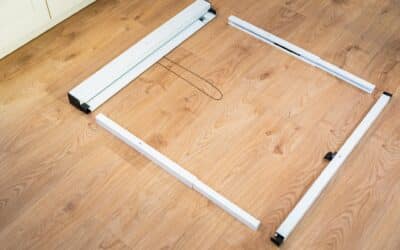The climate has changed noticeably in recent decades. Summers are getting hotter and hotter, which increases the risk of overheating in our buildings. The use of air conditioning systems may seem tempting, but it has considerable disadvantages, particularly in terms of energy consumption. An effective and sustainable solution is external heat protection on windows, such as external roller blinds. In this article, we explain why external heat protection is so important, what advantages it offers and what political measures are needed to promote the use of heat protection systems.
Background and importance of heat protection
The temperature trend in Germany shows a worrying tendency. According to data from the German Weather Service (DWD), the number of days with temperatures above 25 degrees Celsius rose from an average of 28 days between 1961 and 1990 to 40 days by 2007. In the coming decades, this figure will rise to between 58 and 69 days. Extremely hot days with temperatures above 30 degrees Celsius will also increase significantly. This development represents a considerable challenge for our buildings.
Many buildings in Germany are not prepared for these extreme temperatures. Older buildings and new buildings built to outdated standards are particularly susceptible to overheating. The use of air conditioning seems to be a simple solution, but this leads to a massive increase in energy consumption. A Study by the Hauser engineering office (IBH) on behalf of the Transparent Building Envelope Representative Body shows that various sun protection measures are an effective way of preventing overheating and can minimise or even completely avoid energy consumption for air conditioning.
Study results on the effectiveness of heat protection
The study by the Hauser engineering firm (IBH) simulated how standard living spaces would react to future global warming and how overheating can be prevented without air conditioning. In the past, a typical living and dining room with a large south-facing window front just about met the requirements with the best possible internal sun protection. In future, however, this room will regularly exceed 30 degrees in the summer months. Effective external sun shading, such as roller shutters or external blinds, can prevent this overheating almost completely. Sun protection is particularly effective if it is activated automatically so that it is not forgotten even when you are away. In addition, consistent ventilation at night improves the indoor temperature.
Types of sun protection measures
There are various heat protection solutions that can be used depending on the structural conditions. The most common measures include solar control glass, internal and external products. External solar shading, such as external roller blinds, offers the greatest advantage as it directly blocks the sun's rays before they reach the window and can heat up the interior. Automatic control systems that activate the sun protection depending on the position of the sun and the temperature provide additional comfort and efficiency.
Why external heat protection is particularly effective
The physical advantage of external sun protection lies in the direct defence against the sun's rays. While internal solutions already have the sun's heat in the room, external roller blinds prevent the heat from entering the building at all. This keeps the inside temperature stable and comfortable, even on the hottest days. External systems such as roller shutters or blinds are particularly effective if they are controlled automatically so that they can be used optimally even when the occupants are absent.
Political and structural implications
The Transparent Building Envelope Representative Body urgently recommends adapting building regulations and standards. Currently, many specifications are still based on climate data from 1988 to 2007 and do not take current and future climatic changes into account. The DIN standards must be updated to meet the requirements of today's and future summers. In addition, the Building Energy Act should clearly stipulate that the potential of solar shading must be prioritised before air conditioning is used. A revised system of requirements for summer heat protection is necessary to counteract rising temperatures and reduce energy consumption.
Practical examples and success stories
Experience reports show that external heat protection solutions are effective and economical. For example, a residential building in southern Germany that was fitted with external heat protection blinds has seen a significant reduction in indoor temperatures and energy consumption. In the summer months, the building remains pleasantly cool without the need for air conditioning. The investment in such systems is quickly amortised by the savings in energy costs.
Conclusion
The challenge of climate change and increasing summer heat requires effective measures to protect our buildings from overheating. External heat protection systems such as external roller blinds offer a sustainable and efficient solution that not only keeps the indoor temperature stable, but also significantly reduces energy consumption. It is essential that building regulations and standards are adapted to current climatic conditions to ensure the protection of buildings and their occupants.
Find out about the various heat protection solutions and consider how you can protect your home from the summer heat. External roller blinds are an effective way to prevent overheating and save energy costs at the same time. Contact us for personalised advice or click on the button below.
Further links and resources
- Study by the Hauser engineering office (IBH)
- Representation Transparent building envelope
- German Weather Service (DWD)
- Our products and services
By using external thermal insulation, we can optimally prepare our buildings for the challenges of climate change and at the same time make an important contribution to climate protection.







